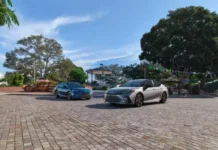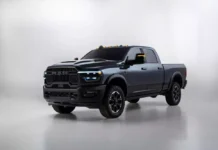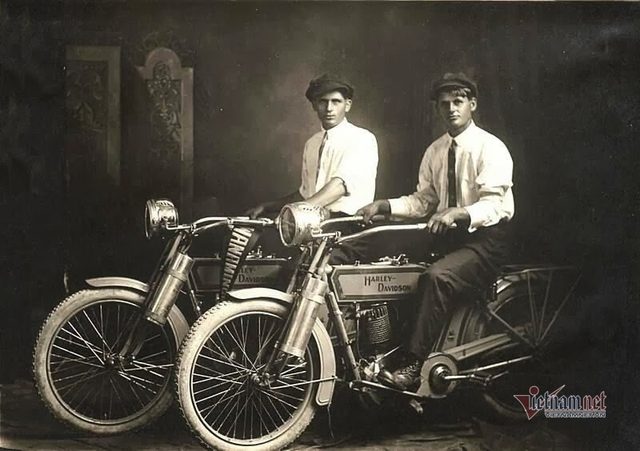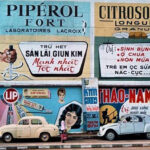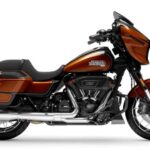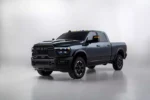Harley-Davidson, an American motorcycle manufacturer, holds the distinction of being the oldest in the United States. It was established in 1903 in Milwaukee, Wisconsin (USA) by two iconic figures: William S. “Bill” Harley (1880 – 1943) and Arthur Davidson (1881 – 1950). Their first creation was a Harley-Davidson bike powered by a small gas engine, marking the beginning of their journey.
Today, the name Harley-Davidson is immediately associated with luxurious touring motorcycles that come with a hefty price tag, ranging from hundreds of millions to several billion Vietnamese dong.
Harley-Davidson motorcycles are renowned for their large size, powerful performance, high fuel consumption, and suitability for taller riders. However, few are aware that the initial Harley-Davidson motorcycles were compact in size and boasted a simple operation. One such example is the 1927 production version.
Mr. Tran Gia Tuan, the owner of Saigon Vintage Market, recently undertook the remarkable task of restoring a 1927 Harley-Davidson motorcycle, driven by his passion for vintage bikes.
According to Mr. Tuan, “Harley-Davidson motorcycles have always ignited the imagination of creative enthusiasts like ourselves. Restoring a 1927 model, with its design and operating technology from the first generation of motorcycles, posed quite a challenge. But fueled by our passion, my friend and I were determined to acquire and restore this bike.”
After an extensive search, they were fortunate to find a suitable vintage motorcycle frame for the restoration of the 1927 Harley-Davidson. This frame was the turning point in restoring the bike to its original condition, emphasized Mr. Tuan.
Given the age and unusable state of the original motorcycle frame, Mr. Tuan had it meticulously reworked to align with the dimensions of the 1927 Harley-Davidson. As a result, the bike showcases a vintage design influenced by early 19th-century technical engineering. Notable distinguishing features include the World War II ambulance bag, acetylene gas lamp, and alarm horn.
The lamp peculiarities, displaying the use of acetylene gas for illumination, are particularly impressive. Initially manufactured for commercial use in 1880 by Prest-O-Light and Corning Conophore companies, this lamp design revolutionized the industry. Corning’s headlamp design, prior to 1917, boasted the ability to illuminate from a distance of up to 152 meters, making it a breakthrough development at the time, predating the invention of electric lamps.
In comparison to modern Harley-Davidson motorcycles equipped with LED headlights, the vintage lamp design employed on this bike, harnessing acetylene gas, represents a significant scientific and technological advancement.
Adding to the bike’s appeal, the alarm horn is fashioned from a ship’s horn, adjusted to complement the overall aesthetic.
Beneath the bike, the elongated and slender gasoline tank underwent meticulous reworking to faithfully recreate the original design. Underneath the bike frame, one can find the characteristic characteristics of late 19th-century Harley-Davidson motorcycles. The handlebar was also reworked to align with the rider’s seated position.
Observing the bike from the rear, the air horn attached to the rear seat was collected from a vintage player, showcasing a distinctive 1940s design. In terms of performance, the original 1924 bike came equipped with a second-generation V-Twin engine (F-Head) introduced in 1911. This engine proved itself to be exceptionally durable, greatly contributing to Harley-Davidson’s business success. Its usage extended until 1929.
However, owing to difficulties encountered during the search process, Mr. Tuan opted for an old 2-stroke engine. Power is transmitted through a belt, rendering the wheels in motion. This principle aligns with famous motorized bicycles such as Mobylette and Vélosolex.
To adjust the belt’s tension and subsequently modify the transmission ratio to increase or decrease the bike’s speed, Mr. Tuan designed a custom lever mechanism integrated into the gearbox. Importantly, it should be noted that this bike is solely suited for display in cafes and not suitable for road use.
Collecting vintage motorcycles has become a passionate pursuit for many affluent motorcycle enthusiasts in Ho Chi Minh City. Over time, what used to be a pastime for a select few individuals has evolved into the formation of numerous groups and communities. Rare models, elevated valuation, and sheer devotion lead enthusiasts to invest substantial sums in cultivating their passion.

